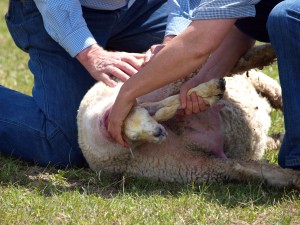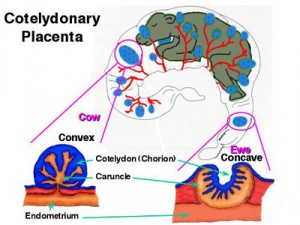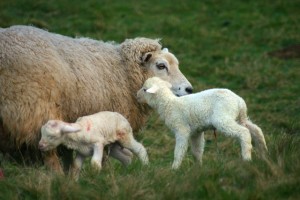Sheep Diseases
Campylobacteriosis in Sheep
Campylobacteriosis is a disease in sheep that causes bacterial abortion storms and still births. In the United Kingdom, campylobacteriosis ranks third after enzootic abortion and toxoplasmosis as a cause of abortion and affects about 5% of all abortions. In New Zealand, Campylobacter spp. and Salmonella brandenburg are the primary organisms that induces abortion in sheep (West, 2002) and, in North America, Campylobacter spp. is a significant cause of small ruminant abortion (Hazlett et al., 2013; Sahin et al., 2008).
Campylobacter spp. are Gram-negative, non-sporing, curved or spiral rod-shaped bacteria that colonise the gastrointestinal tract of a broad range of animals, and can cause associated disease in cattle, pigs and poultry. Campylobacteriosis in sheep is caused by either Campylobacter fetus ssp. fetus intestinalis (C. fetus subsp fetus) or Campylobacter jejuni (C. jejuni).
In recent years there has been a shift from C. fetus subsp fetus being the predominant isolate in the US, to C. jejuni (Sahin et al., 2008). In the US, treatment or prevention of abortion storms associated with Campylobacter spp. traditionally relied on chlortetracycline, or tetracycline in the feed. However, a recent study found that all isolates of C. jejuni associated with ovine abortion in the US are resistant to tetracycline (Lacasta et al., 2015). This is not true for Campylobacter fetus ssp. foetal abortions in the UK however, for which tetracylines are still widely used and resistance is unconfirmed.

Campylobacter spp. is a significant zoonotic bacteria commonly associated with food-borne illnesses in industrialised countries (Stanley and Jones, 2003). In sheep husbandry it can be transmitted to humans through direct contact with uterine discharge and foetal membranes. Farm personnel who have handled infected animals can also transfer infection to susceptible animals.
Campylobacter spp. are a significant zoonotic pathogen as they are commonly associated with outbreaks of food-borne illness in humans in the USA, UK and other industrialised countries (Stanley and Jones, 2003).
The most important risk factor for human Campylobacter spp. infection was thought to be the handling and consumption of raw poultry products, however, there is now a growing body of molecular evidence that suggests the significance of non-poultry sources has been underestimated (Stanley and Jones, 2003). Nevertheless avian species are purported to be the natural hosts of thermophilic campylobacters because they have a core temperature of 42°C, which is the optimum growth temperature of C. jejuni (Stanley and Jones, 2003).
Agricultural run-off contaminating water courses, and faecal contamination of milk which is then improperly pasteurized milk accounts for large outbreaks of human Campylobacter spp. infections around the world.
Campylobacter spp. isolates are readily detected in the intestinal tract of healthy ruminants, however isolation rates vary between herds and flocks. Factors such as stocking density, season, age of animal, sample site and isolation method, geography, diet and husbandry practices, have been suggested to account for differences (Stanley and Jones, 2003). For example, a high incidence of C. jejuni has been observed in cattle raised in feedlots compared with cattle on pasture (Garcia et al., 1985).
Campylobacteriosis and Abortion Storms in Sheep

Ewes and Cows have a cotelydonary placenta. Campylobacter spp infection in ewes during pregnancy cause the carnacules to separate from the cotelydons. The bacteria are then shed in the aborted material. This image is from www.anisci.wisc.edu/jjp1/ansci_repro
/lab/lab12_03/placent1.html
Active Campylobacter spp. infection in pregnant ewes causes abortion storms in late pregnancy or full-term birth of dead or weakly lambs. The disease causes placentitis and the cotyledons separate easily from the caruncles (See image). Abortions are more common beyond the twelfth week of pregnancy and usually occur between 7 and 25 days after infection (Mearns, 2007). Once abortions start, healthy ewes can be exposed to high levels of Campylobacter organisms through contact with aborted foetuses, placenta and uterine discharges (Sahin et al., 2008). Campylobacter abortions may be characterised by serosanguinous fluid throughout the abdomen and thorax and focal liver lesions.
The disease is self-limiting, as immunity develops in the flock through contact with carriers. An outbreak is usually confined to one lambing season (The Henston Vade Mecum, 1998), but may recur after a 5-7 year gap. Seasonality in Campylobacter spp. recovery from cattle and sheep in Great Britain has been reported.
Campylobacter spp. can be carried in the intestines and gall bladder of healthy sheep without causing clinical diseases (Mannering et al., 2006), in fact intestinal infection is probably close to 100%, however it is the shedding of Campylobacter spp. that varies with season and diet.
A study of Campylobacter spp. shedding by grazing sheep on lowland farm land, saltmarsh and upland fells in North Lancashire, UK, revealed that the organism was intermittently shed depending on season. Campylobacter spp. shedding was lowest (0%) in November and December when sheep were fed on hay and silage compared with when they were grazing pasture (Jones et al., 1999). The highest rates of shedding (100%) coincided with increased stress as a result of lambing, weaning and movement onto new pasture.
Effects of Lambing on Colonisation of Campylobacter in Ewes
The same study in North Lancashire, UK found that Ewes that were not shedding Campylobacter spp. before lambing began shedding 3 days after lambing while ewes that shed low numbers before lambing subsequently shed huge amounts of Campylobacter spp. after lambing, and within 5 days of being born, 100% of lambs born to either set of ewes were colonized (Jones et al., 1999).
Control and Prevention of Campylobacteriosis

Care should be taken on farms which practice outdoor lambing, as Campylobacter spp can remain viable in uterine discharge and foetal membranes for several days.
Abortion occurs 7-25 days after infection and spreads rapidly due to the large numbers of organisms in aborted material. Isolation of aborting ewes, and correct disposal of contaminated bedding, and aborted material is vital in limiting the spread of disease (Mearns, 2007).
As the organism is spread via ingestions of contaminated feed and water, susceptible animals should be removed from suspect areas (Mearns, 2007).
Once an outbreak of abortion due to campylobacteriosis occurs, the possibilities of preventing further abortions are limited and should be discussed with the farm vet.
If the flock is free of the disease, bought-in stock must not be mixed with the flock during pregnancy (Mearns, 2007).
Hygienic measures should be taken to prevent the disease from spreading to adjacent flocks and wildlife vectors, as infection can easily be transmitted on vehicles and boots. The organisms can remain viable in uterine discharge on pasture and bedding for several days.
Vaccinating against Campylobacter Abortion Storms
In the USA, Canada and New Zealand killed adjuvant vaccines are widely used, however none are licensed to be used in Europe (Lacasta et al., 2015). However, Campyvax 4 can be imported in the UK by a veterinary surgeon. The vaccines consist of a primary course of 2 injections given pre-mating followed by an annual booster. They do not offer cross-protection across isolates so whether these vaccines are fully effective in controlling sheep abortions, and confer immunity against the Campylobacter spp. in these countries is debated (Sahin et al., 2008).
Treating Campylobacteriosis
Once a diagnosis has been made in an outbreak, the vet may consider it worth treating in-contact ewes which have yet to lamb, preferably with long-acting penicillin, but there is no evidence that therapy alone is useful.
Campylobacteriosis and Welfare
While the maternal campylobacteriosis infection is usually mild, the consequences for the foetus are more serious. Lambs may be carried full term but born dead or in a weak condition.
In case of an outbreak, efforts should be made to prevent the disease from spreading amongst the flock through clearing up and abortion material and keeping feed and water troughs free from faecal contamination from birds, wildlife and other animals.
Good Practice Based on Current Knowledge
- In case of an outbreak, prevent the disease from spreading to adjacent flocks and wildlife vectors from foetal membranes and aborted foetuses through hygienic measures. The disease can easily spread on, bedding, boots and clothing
- To date there is no evidence linking campylobacteriosis in ewes to campylobacteriosis in pregnant women, however pregnant women should avoid touching aborted sheep foetuses and fluids (Sahin et al., 2008).


 American English
American English

Comments are closed.